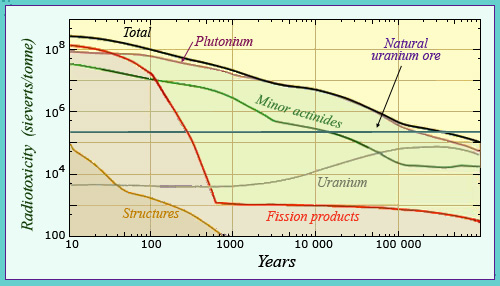Plutonium: hazardous waste or miraculous raw material?

Plutonium is the most radiotoxic radioactive component of spent fuel
The figure shows the relative contribution of the various constituents of spent fuel to overall radiotoxicity over time. With the exception of a short period of fifty years, which is by the way still ongoing, plutonium is the most toxic. It will take 200,000 years for a spent fuel assembly to return to the same level of toxicity as the natural uranium from which it was made.
© CEA
For those who advocate pulling out of nuclear energy, plutonium is a hazardous, highly radiotoxic element for which the only foreseeable future is disposal as waste. For those who support continued use of nuclear energy, plutonium is an extraordinary potential source of energy – a single gram is equivalent to one or two tonnes of oil – and, as such, must be put to the best possible use.
The options as to what to do with plutonium are radically different depending on the weight given to the above arguments.
Option 1: It is decided not to recycle plutonium and therefore not to extract it from spent fuel from reactors. Given the intrinsic hazard it represents, this spent fuel, now considered as radioactive waste, must be disposed of with the greatest care. Considered as waste, spent fuel is bulkier, longer-lived, gives off more heat, and is more radiotoxic than vitrified waste rid of its plutonium.
Buried plutonium would be tempting for those wishing to recover it as a source of energy and for those with less respectable intentions. Plutonium from a reactor could be used by terrorists, even if it is considered as dirty because it cannot be used to make an atom bomb. A dirty bomb might not be very destructive, but it would spread radioactivity and have a significant psychological impact.
Option 2: It is decided to extract plutonium from spent fuel and burn as much of it as possible by incorporating it as fissile material in mixed uranium/plutonium fuels to recover the available energy. This option is adopted in France by loading MOX fuel in some nuclear power reactors. The drawback, however, is that fresh plutonium is generated when the MOX is in the reactor, so this solution does not eliminate plutonium. Recycling MOX certainly slows down the growth of the plutonium inventory, but does not stop it from growing. So the question is what should be done with all this plutonium? Dispose of it as waste or burn it without creating more in the process?
Fast reactors could be a third option. Some forecasters consider that the global demand for energy will be ten times greater by 2050 due to the economic emergence of nations currently considered as developing countries, and to world population growth. It seems that more efficient, safer and cleaner reactors could be used to generate as much energy as required without adding to the greenhouse effect. If the energy challenges of the 21st century are to be met, adequate reserves of plutonium will be needed when the time comes to start up new fast reactors.
Within this context, thorium-uranium-233 reactors would provide an attractive solution as they would ultimately destroy plutonium. Unlike conventional reactors, thorium reactors would not create any plutonium and could be used to destroy the existing plutonium inventory. Although prototypes have operated in the past, it is proving difficult to develop these reactors.
This type of reactor, however, requires uranium-233 to start up, and uranium-233 does not exist in nature. Fast reactors partially loaded with plutonium would probably be needed to produce the required quantity of uranium-233 rapidly.
Other articles on the subject « The waste issue »
Waste or resource?
Spent fuel can still generate a lot of energy The fuel removed from a reactor core after three or[...]
Fuel Reprocessing
The spent fuel reprocessing option Spent fuel reprocessing is derived from a process called the P[...]
Alternative to reprocessing
Leave fuel as it is : do not reprocess If the spent fuel does not undergo reprocessing, the fuel [...]
What to do with plutonium
A highly strategic material and a hazardous type of waste What becomes of plutonium is central to[...]
Costs comparison
Reprocessing or not reprocessing: a comparison Which option for dealing with spent fuel from reac[...]